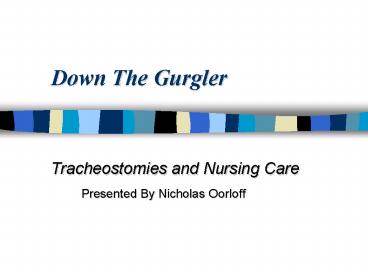Down The Gurgler PowerPoint PPT Presentation
1 / 24
Title: Down The Gurgler
1
Down The Gurgler
- Tracheostomies and Nursing Care
- Presented By Nicholas Oorloff
2
Tracheostomies and Nursing Care
- Included in my presentation
- What is a tracheostomy?
- Tracheostomy tubes and their insertion
- The operation
- Following surgery
- Equipment Required
- Suctioning
- Precautions with a tracheostomy
3
What Is A Tracheostomy?
- A surgical opening into the trachea below the
voicebox - it provides an alternative airway, bypassing the
upper passages
4
Tracheostomy Tubes
- a tracheostomy tube is
- inserted through the tracheostomy to maintain a
patent airway - secured in place by tapes tied around the neck
5
Velcro Tracheostomy Ties
6
Some Indicators For Tube Insertion
- Subglottic Stenosis
- an area of thickened scar tissue on the inner
linning of the trachea, just below the vocal
cords (subglottic region) - Subglottic Haemangioma
- highly vascular mass just below the vocal cords
(subglottic region) - Vocal Cord Paralysis
- inability of vocal cords to open and close
properly during breathing
7
Indicators For Tube Insertion (cont)
- subglottic stenosis
- subglottic haemangioma
- vocal cord paralysis
- all of the above result in narrowing or complete
blockage of upper airways resulting in difficulty
breathing - insertion of the tube below the level of the
blockage allows upper airway to be bypassed
8
The Operation
- Takes about thirty minutes
- Procedure involves
- horizontal incision made into the skin
- vertical incision made through the rings of
trachael cartilage - layers of skin and muscle are sutured to provide
a path for the trache tube to follow - sutures remain for about 10 days
9
The Operation (cont)
10
Following Surgery
- child spends next 4-5 days in ICU or until the
first tube change has been performed - a doctor performs the first tube change to
prevent false tracts from developing, due to
incorrect insertion procedure, as the opening
into the airway or stoma is not well formed at
this stage
11
Following Surgery (cont)
- When the baby cries little or no voice will be
heard - as air no longer passes across the vocal cords
which creates voice - However, some children may have a slight leak
around tube allowing some air to pass and vibrate
the vocal cords creating a softer voice
12
Equipment (to be with child at all times)
- Two tracheostomy tubes attached to the bed
- one the same size as the childs
- one a size smaller
- This is in case the tube becomes blocked and
needs to be changed in an emergency - Trachael dilators attached to the bed
- to open stoma
- suction equipment
13
Nasal Breathing
- Normally nasal breathing
- humidifies
- filters and
- warms air before it enters our lungs
- the tracheostomy bypasses these mechanisms so
that the air is cooler, dryer and not as clean.
In response to these changes the body produces
more mucous, which may require humidification to
aid expulsion
14
Humidified Oxygen Via Tracheostomy
15
Humidified CPAP Via Tracheostomy
16
Suctioning a Tracheostomy
- Procedure requires
- wall suction
- suction catheters (size of catheter determined by
doubling the size of the tracheostomy tube in
French Gauge i.e size 3.5 trache requires size
7.0 suction tubing) - 0.9 normal saline and syringe
- Procedure involves
- washing your hands
- attach suction catheter to tubing
- measure suction catheter against pre measured
tape - prevents suction catheter being passed too
deep and causing trauma to tissue
17
Suctioning a Tracheostomy (cont)
- pass suction catheter into tubing and suction
- observe type of secretions removed
- i.e colour and consistency
- allow child five breaths before repeating
- rinse suction tubing with clean water
- Saline Instillations
- 0.2-0.3ml of normal saline can be instilled into
the tracheostomy to thin secretions, suction
should follow immediately
18
Tracheostomy Tube Changes
- tracheostomy tubes are routinely changed weekly
or any time a blockage is suspected - tubes are changed to prevent build up of
secretions on the wall of the tube - the change occurs before the child has a feed to
minimise the risk of aspiration - to be demonstrated in video
19
Eating With A Tracheostomy
20
Eating With A Tracheostomy
- a tracheostomy will not usually affect the
ability of a child to swallow - encouraging fluids helps to thin secretions
21
Some Precautions With a Tracheostomy
- water is a serious threat
- child has lost ability to protect airway, as the
gag reflex is bypassed - no swimming
- no showering
- avoid clothing that blocks the tracheostomy
- accidental decannulation- most common cause of
death in children with tracheostomies
22
Tracheostomy Complications
- children with tracheostomies are more prone to
respiratory infections - tracheostomy tube bypases bodies defence
mechanisms - some signs of infection
- febrile
- inflammed stoma site
- foul odour emitted from tracheostomy
23
In Summary
- tracheostomies are often created to bypass upper
airway obstructions - the child must have in their vicinity at all
times, one tube the same size and one a size
smaller incase of blockage - children with tracheostomies must be supervised
around water - children with tracheostomies are more prone to
respiratory infections
24
References
- internet
- www.tracheostomy.com
- http//wellness.ucdavis.edu/child
- www.rch.unimelb.edu.au/intranet/handbook/trach.htm
- texts
- Myer.C, Cotton.R, Shott.S,1995 The Pediatric
Airway, J.B Lippincott company Pennyslvannia

